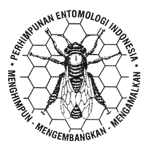Keanekaragaman Serangga Hama dan Musuh Alami pada Lahan Pertanaman Kedelai di Kecamatan Balong-Ponorogo
DOI:
https://doi.org/10.5994/jei.7.2.116Keywords:
diversity, pests, predators, parasitesAbstract
The study aims to determine the presence of pests and natural enemies on soybean plants and to study the effect of insecticides on the diversity. Methods for observation of insects was done by using different type of traps i.e. yellow pan trap, pitfall trap, light trap, sweeping net and direct observation (visual). The presence of pests and natural enemies of soybean plants on plots without insecticide was lower than on the plots that was treated with insecticide. Composition of the population of pests found in soybean plots that were not treated with insecticide were dominated by Aphis sp. followed by Phaedonia inclusa, Riptortus linearis, Nezara viridula and Ophiomyia phaseoli. Composition of the population of natural enemies (predators) found in soybean cropps that were not treated with insecticide was family Coccinellidae followed by Syrphidae, Chrysopidae, Mantidae and Oxyopidae. The highest composition of natural enemies (parasites) found in treated and untreated soybean plots were family Braconidae then followed by family Ichneumonidae.Downloads
Downloads
Published
How to Cite
Issue
Section
License
Authors who publish with this journal agree to the following terms:
- Authors retain copyright and grant the journal right of first publication with the work simultaneously licensed under a Creative Commons Attribution 4.0 International License that allows others to share the work with an acknowledgement of the work's authorship and initial publication in this journal.
- Authors are able to enter into separate, additional contractual arrangements for the non-exclusive distribution of the journal's published version of the work (e.g., post it to an institutional repository or publish it in a book), with an acknowledgement of its initial publication in this journal.
- Authors are permitted and encouraged to post their work online (e.g., in institutional repositories or on their website) prior to and during the submission process, as it can lead to productive exchanges, as well as earlier and greater citation of published work (See The Effect of Open Access).








